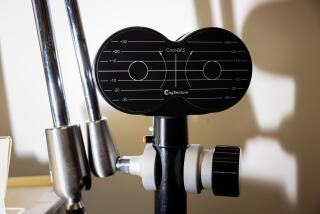Using Magnets to Peek Inside the Body
- Share via
SAN FRANCISCO — “You’d better remove your watch,” says Dr. Michael C. Weiner cheerfully as a visitor enters his laboratory in the basement of the Veterans Administration Medical Center here. “And leave behind your credit cards. The magnetic field can ruin them, too.”
Under its protective canopy, the source of this potential mischief dominates the lab. With its tunnel-like openings at each end, the large pickup-truck-size contraption vaguely resembles a CT (computed tomography) scanner. And like such high-tech X-ray machines, Weiner’s monster almost swallows up the patient during an examination.
Both are diagnostic devices, capable of revealing many of the body’s secrets. But there’s an important difference. Once the patient--or at least the bulk of him or her--is slid into Weiner’s machine, he’s exposed not to X-rays but to a powerful magnetic field many thousands of times stronger than the Earth’s.
While such a strong dose of magnetism may be hard on non-quartz watches or credit cards (to say nothing of pacemakers and other electro-mechanical devices), it ordinarily poses no threat whatsoever to people, Weiner says. Indeed, it may do them a lot of good.
Without biopsies or other intrusive procedures, the technique lets doctors tell how the patient’s body is working down to the level of the chemistry of the cells. For the first time, metabolic processes can be studied non-invasively almost as they occur. “You don’t have to resort to a scalpel, needle or radiation,” Weiner says.
This medical marvel goes by the name of magnetic resonance spectroscopy (MRS). Although not generally available yet, it is being actively explored for clinical use by half a dozen medical research teams across the United States, including Weiner’s unit, which is also affiliated with the nearby UC San Francisco. “The goal,” he says, “is to develop MRS as a major new tool in the diagnosis and treatment of disease.”
Dr. William Bradley, head of the magnetic resonance program lab at the Huntington Medical Research Institutes in Pasadena, adds, “There’s at least a 50-50 chance we’ll be doing clinically useful things with MRS within three years.”
While MRS provides data readings of the chemistry of small, specific areas of the body, its close kin, magnetic resonance imaging (MRI), produces actual detailed images of the interior of the body. Both techniques operate through a novel use of magnetic fields and radio waves that in effect turn the body’s atoms into little radio transmitters that broadcast clues to its inner workings.
Since its introduction less than a decade ago, MRI has grown dramatically. About 1,200 magnetic resonance scanners, each costing $1 million or more, are in use in the United States, about a quarter of them in California. Bradley’s team leads the state, having done about 15,000 scans in the past five years.
Nowhere was the field’s growth more evident than at the recent annual meeting here of the Society of Magnetic Resonance in Medicine. Only 8 years old, the Berkeley-based society attracted more than 2,500 physicians and scientists from a score of countries. They heard more than 1,200 scientific papers and saw manufacturers such as General Electric, Siemans, Philips and Diasonics display a dazzling array of new equipment as they compete for the $1-billion-a-year scanner market.
Both imaging and spectroscopy depend on a physical phenomenon called nuclear magnetic resonance (NMR) discovered in the 1930s. Physicists found that atomic nuclei--the centers of atoms--absorbed or emitted tiny amounts of energy if they were excited by rapidly changing magnetic fields.
In the 1940s, physicists Felix Bloch at Stanford and Edward Purcell at Harvard showed independently that these telltale signals, called spectra, could be used like fingerprints to identify atoms or molecules. In 1952, the two researchers shared the Nobel Prize in physics for their pioneering work.
NMR spectroscopy soon found a home in chemistry where it was put to work identifying and analyzing a wide variety of materials. It was also of interest to medical researchers because the magnetic fields could be used to study living tissue without destroying it.
But the next big step was not possible until two developments took place. Scientists could not create images without high-speed computers, capable of processing and assembling the flood of signals from a subject. They also needed powerful magnets to produce strong, sustained magnetic fields.
By 1974 scientists at the University of Aberdeen in Scotland displayed the first magnetic resonance image of a living creature, a cross-section view of a mouse. They used emissions from the nuclei of hydrogen atoms, the simplest element, consisting of single protons.
Commercial scanners became available by 1980. Doctors shortened the name of the new technology to magnetic resonance, dropping nuclear to avoid stirring unnecessary fears among their patients. Still, the new machines touched off a debate. Critics argued that at a cost of about $750 per imaging session, they would only add to the nation’s soaring medical bills. Besides, CT scans were already available at about half the price.
But MRI had undeniable advantages over the rival technology. Apart from the absence of any potentially damaging radiation, the new machines produced “slices” of the body in any direction. A cross-sectional view looking down on the brain was as easy to obtain as a frontal image of the heart. The computer simply sampled the signals coming from a particular plane and assembled this information into a picture. In CT scanners, the patient must be mechanically rotated to change the angle of view.
Equally important, magnetic resonance revealed bodily details hidden to X-rays, especially soft tissue, such as cartilage, organs and fluid-filled cysts. By 1985 MRI got its biggest boost yet when Medicare agreed to pay for the scans.
Just how far MRI has come as a clinical tool was emphasized at the conference here. Doctors reported that MRI scans are turning up early evidence of tiny strokes and blockages in the blood vessels. At Huntington Medical Research Institutes in Pasadena, 30% of patients over 60 who had undergone scans showed signs of such mini-strokes even though they displayed no external dysfunction. MRI is also picking up herniated disks and damaged knees that do not turn up on X-rays.
For some purposes, CT scans still hold an edge. Dr. Leslie Katz, director of Stanford’s magnetic resonance lab, notes that aneurysms--blockages of blood vessels--may sometimes show up with CT and not with magnetic resonance. CT is also superior in visualizing calcification, as in arthritis.
But MRI has been especially valuable in detecting tumors and abnormalities in the brain. One example: the minuscule plaques that indicate the onset of multiple sclerosis, a degenerative disease of the nervous system that afflicts about 250,000 Americans. The lesions are being seen before any overt symptoms of the disease.
Paradoxically, MRI’s older kin, magnetic resonance spectroscopy, has been slower to catch on among doctors. In part, the reason lies in the more stringent technical requirements. MRS signals are more difficult to detect--they come from the nuclei of atoms other than hydrogen--and require much higher magnetic fields, which in turn require expensive superconducting magnets.
(The Food & Drug Administration currently recommends a maximum exposure of 2 tesla, 40,000 times the strength of the Earth’s field. At Philips’ lab in Hamburg, West Germany, fields of 4 tesla are being used on patients without ill effect).
But as new scanners appear on the market that can do both spectroscopy and imaging, it is clear the obstacles are being overcome with new hardware and improved computer techniques that obviate the need for powerful magnets.
Researchers have recently shown that MRS can detect critical chemical changes in cancerous cells almost immediately after the administration of an anti-cancer drug. This should enable doctors to determine very quickly--within minutes instead of days or weeks--whether a particular course of therapy is working.
MRS has also been used experimentally to monitor the growth of tumors in the brain as well as to shed light on the complex metabolic processes associated with breakdown of functions in the heart, kidneys and liver, including those connected with AIDS. One tactic is to monitor changing levels of key substances like the energy-storing compound ATP, the fuel for myriad bodily reactions. Changes can be detected almost immediately.
At the conference, Yale Univerity’s James W. Prichard, who had used himself as a guinea pig, showed that the spectra of his brain revealed a sharp rise in ethanol--alcohol--only moments after he drank champagne. Says Prichard, “We’re allowed to look into a lot of places where we were not allowed to look by other means.” A West German team from Gottingen reported variations in the levels of lactic acid in the brain’s visual center when the eyes of subjects were open or closed. This work suggests that MRS could be used for mapping brain function.
Other researchers, including Dr. Robert Miller of UC San Francisco, have been studying metabolic changes in muscle produced by exercise, circulatory failure and various diseases. “Even after a 100 years of study, we still don’t really understand muscle fatigue,” says Miller, whose study is one of the first of its kind involving humans rather than animals.
One characteristic of muscle fatigue revealed by MRS appears to be a rise in the concentration of phosphates and increasing cellular acidity. Miller hopes the work of his group can help suggest treatment for the muscle-weakening effects of such diseases as multiple sclerosis, myasthenia gravis and amyotrophic lateral sclerosis (Lou Gehrig’s disease).
At Huntington, Bradley expanded research into the clinical applications of MRS by recently hiring British spectroscopist Brian D. Ross of Oxford University. He will concentrate on metabolic diseases of the brain, heart and liver.
Like Weiner, Bradley feels MRS holds special promise in monitoring cancer treatment. Says Bradley, a physician with a doctorate in chemical engineering, “In 20 years, they’ll regard our current approach as the Stone Age. The metabolism of cancer cells fluctuates from day to day, yet we dose patients with drugs and radiation without any idea of what stage the cells may be in at the moment.”
As someone who spends as many as 17 weeks a year on the road lecturing about magnetic resonance, Bradley admits that he is an unabashed apostle of both imaging and spectroscopy. But he feels his enthusiasm is justified. In his view, even the early detection of diseases that cannot yet be cured, like multiple sclerosis, is worthwhile. “If you can follow the course of a disease, watching it as it develops, you vastly improve your chances of devising a treatment,” he says.
Weiner adds, “Our overall goal is to determine what is normal, what are the effects of disease, and then to use our findings to develop new treatments.”






